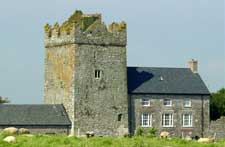|
"The
Normans landed in Wexford in 1169. They came from around Carmarthenshire
in Wales under the leadership of Strongbow at the invitation of the then
King of Leinster Dermot McMurrough. They introduced the feudal system
to Ireland and made grants of lands to the mercenary leadership. The names
of Rochford, Sinnott, Walsh, Codd, Stafford etc were introduced
into Ireland at this time."
http://www.esatclear.ie/~lorcand/history.htm
From BBC
History: "In 1166, the King of Leinster, Diarmait MacMurchada was
forced to flee from Dublin and from his kingdom by an alliance of Irish
enemies, including the new High King, Ruaidri Ua Conchobair. 'Awful the
deed done in Ireland today', wrote the chronicler of Leinster, 'the expulsion
overseas by the men of Ireland of Diarmait...'.
And awful
were its consequences. For Diarmait landed in Bristol and asked for help
from King Henry II to get his throne back. Now what happens when you ask
the Godfather for a favour? He expects something, some day, in return.
And, as the Song of Dermot made clear, from the beginning that something
was:
To you I
come to make my plaint, good sire In the presence of the barons of your
empire. Your liege-man I shall become henceforth all the days of my life,
On condition you be my helper so that I do not lose at all You I shall
acknowledge as sire and lord...
Then the King promised him, the powerful king of England That willingly
would he help him as soon as he should be able.
But these
were the years of Henry's great crises: the feud with Becket and the church
- and the coming wars with his son, the future Richard I. In 1155, the
Pope had asked Henry to invade Ireland to clean up what was reported to
be a corrupt and lax Christianity.
But then,
as now, Henry had more urgent things to do than get directly involved
in an obscure island west of England's shores. On the other hand, Diarmait's
appeal had presented him with a windfall too good to turn down. So he
gave Diarmait permission to recruit help from among his barons.
This is when
the trouble became big trouble. For Diarmait promptly went shopping for
mercenaries among the nastiest and greediest possible bunch of knights.
These were the Anglo-Normans who, around the 1160s, seemed to be on the
losing end of the war against the Welsh princes of Gwynedd.
They had
lost castles, land and peasants. They were in an ugly mood and they were
looking for somewhere to recoup their losses. Enter Diarmait.
Spread the
word, the likes of Robert fitzStephen and Richard fitzGilbert de Clare
(known to his friends, and especially to his many enemies, as 'Strongbow')
must have said: 'Forget about Wales; forget about those unpleasantnesses
in the mountains and valleys. Come west young knights. Ireland will be
a piece of cake. It's said that the natives are primitive. But the pastures
are green. So what are you waiting for?'."
http://www.bbc.co.uk/history/state/nations/ireland_invasion_03.shtml
|
|
"THE
New Settlers who joined Strongbow in Ireland, and got large grants of
lands, were:
In Wexford--Maurice Fitzgerald, ancestor o{ the earls of Kildare and Desmond;
Harvey de Monte Morisco, and Robert Fitzstephen. The other families who
settled in Wexford were those of Carew, Talbot, Deveroux* Stafford, Sinnott,
Sutton, Keating, Power, Walshe, Fitzharris, Fitzhenry, Derenzy, Masterson,
Butler, Brown, Rositer, Redmond, Esmond, Hore, Harvey, Hay, Hughes, Codd,
Comerford, Colclough, Lambert, Boyce, Morgan, Tottenham, Ram, Furlong,
etc.
In the first volume of the Desiderata Curiosa Hibernica, an account is
given of various patentees and undertakers who, in the reigns of Elizabeth
and King James the First, got extensive grants of forfeited lands which
were confiscated in the county of Wexford. The following persons obtained
lots of those lands: Sir Richard Cooke, Sir Laurence Esmond, Sir Edward
Fisher, Francis Blundell, Nicholas Kenny, William Parsons, Sir Roger Jones,
Sir James Carroll, Sir Richard Wingfield, Marshal of the Army; Sir Adam
Loftus, Sir Robert Jacob, Captain Trevellian, Captain Fortescue; and Conway
Brady, Queen Elizabeth's footman. Several families of the Old proprietors
in Wexford are enumerated, with the lands they possessed, and the re-grants
of part of those lands which they obtained; as those of Masterson, MacMurrough,
MacBrien, MacDowling, MacDermott, Malone, Cavanagh, Moore, O'Bulger, O'Doran,
Sinnot, Walsh, Codd, etc."
http://www.angelfire.com/my/tray/Page-8.htm
|

